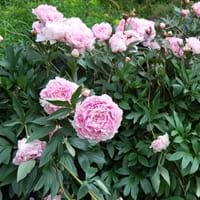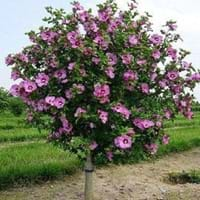Life Span
Perennial
Annual and Perennial
Type
Flowering Plants, Shrubs
Deciduous Shrub, Ornamental Plants, Shrub
Origin
Asia, North America, Southern Europe
Not Available
Types
Aristocrat, Buckeye Belle, Henry Bockstoce , Abalone Pearl, Coral Supreme, Cytherea, Charlie's White
Diana, Oiseau Bleu, Hamabo, Red Heart, Notwoodone, William R. Smith, Meehani, Woodbridge
Habitat
Hillside, Woods
gardens
USDA Hardiness Zone
3-9
5-9
Sunset Zone
A3, 1a, 1b, 2a, 2b, 3a, 3b, 4, 5, 6, 7, 8, 9, 10, 11, 12, 13, 14, 15, 16, 17, 18, 19, 20, 22
2a, 2b, 3a, 3b, 4, 5, 6, 7, 8, 9, 10, 11, 12, 13, 14, 15, 16, 17, 18, 19, 20, 21, 22, 23, 24
Habit
Clump-Forming
Upright/Erect
Flower Color
Pink, Red, White
Dark Pink, Light Pink, Pink
Flower Color Modifier
Not Available
Bicolor
Fruit Color
Not Available
Non Fruiting Plant
Leaf Color in Spring
Dark Green
Green, Light Green, Yellow
Leaf Color in Summer
Dark Green, Green
Light Green
Leaf Color in Fall
Bronze, Dark Green, Green
Yellow, Green, Pink
Leaf Color in Winter
Not Available
Gold, Tan
Leaf Shape
Compound
Ovate and toothed
Plant Season
Spring
Spring, Summer, Fall, Winter
Sunlight
Full Sun, Part sun
Full Sun, Partial Sun
The pH of Soil
Neutral
Neutral
Soil Drainage
Well drained
Well drained
Bloom Time
Spring, Summer
Early Summer, Summer, Late Summer, Early Fall, Fall, Indeterminate
Tolerances
Not Available
Drought, Variety of soil types
Where to Plant?
Ground, Pot
Ground, Pot
How to Plant?
Grafting, Seedlings, Stem Planting, Transplanting
Stem Cutting, Tip cutting, Vegetative Reproduction
Plant Maintenance
Medium
Medium
Watering Requirements
Does not require lot of watering, It cannot sustain wet-feet, Keep the ground moist but not water-logged, Needs watering once a week, Prefer drip-irrigation instead of Over-head watering, Water occasionally
It cannot sustain wet-feet, Keep the Soil well drained, Requires watering in the growing season, Water Deeply, Water frequently while growing, Water more in summer, Water when soil is dry
In Summer
Lots of watering
Lots of watering
In Spring
Moderate
Moderate
In Winter
Average Water
Average Water
Soil Drainage Capacity
Well drained
Well drained
Sun Exposure
Full Sun, Part sun
Full Sun, Partial Sun
Pruning
Do not prune during shooting season, Prune to control growth, Remove dead or diseased plant parts, Remove deadheads
A hard prune may be necessary if the plant becomes woody, Cut leaves after fall, Cut or pinch the stems, Pinch or prune as they grow to promote branching and bushiness, Prune for shortening long shoots, Prune in early summer, Remove deadheads
Fertilizers
All-Purpose Liquid Fertilizer
Apply 10-10-10 amount, Balanced liquid fertilizer, Do not fertilize new plants until at least a month, Use a low phosphate fertilizer to improve the quality of the blooms
Pests and Diseases
Botrytis Blight, Leaf spot, Stem spot, Viruses
Aphids, Mealybugs, Red spider mite, Scale, Thripes, Whiteflies
Plant Tolerance
Drought
Drought, Variety of soil types
Flower Petal Number
Semi-Double
Single
Foliage Texture
Coarse
Medium
Foliage Sheen
Glossy
Glossy
Attracts
Ants
Bees, Butterflies, Hummingbirds
Allergy
Not Available
no allergic reactions
Aesthetic Uses
Beautification, Bouquets, Showy Purposes, Used for decorating walls, fences, gates, hedges, etc.
Beautification, Borders, Landscape Designing
Beauty Benefits
Not Available
Hair Conditioner, Not Available, Prevents greying of hair, Prevents Premature Baldness, Promotes Healthy Hair, Promotes healthy skin, Speed hair growth
Environmental Uses
Air purification
Air purification
Medicinal Uses
Cough, Gout, Headache, Heartburn, Kidney problems, Upset stomach, Urinary tract problems
anti-inflammatory, Diuretic, Hair Loss, High blood pressure, Vitamin C
Part of Plant Used
Flowers, Root, Seeds
Flowers, Leaf Stalks, Leaves
Other Uses
Showy Purposes, Used as Ornamental plant, Used for fragrance
Showy Purposes, Used as Ornamental plant, Used for fragrance
Used As Indoor Plant
No
No
Used As Outdoor Plant
Yes
Yes
Garden Design
Feature Plant, Foundation, Mixed Border
Container, Foundation, Houseplant, Mixed Border, Tropical
Botanical Name
Paeonia lactiflora
Hibiscus syriacus
Common Name
Herbaceous Peony
Syrian ketmia, Rose mallow, St Joseph's rod, Shrub Althea
In Hindi
Herbaceous peony
Rose of Sharon Hibiscus
In German
Krautige Pfingstrose
Rose von Sharon Hibiscus
In French
pivoines herbacées
Rose de Sharon Hibiscus
In Spanish
peonía herbáceas
Rosa de Siria Hibiscus
In Greek
ποώδη παιωνία
Rose της Sharon Hibiscus
In Portuguese
peônia herbáceas
Rosa de Sharon Hibiscus
In Polish
piwonii zielnych
Rose of Sharon Hibiscus
In Latin
herbaceum AGLAOPHOTIS
Rose of Sharon Hibiscus
Phylum
Magnoliophyta
Magnoliophyta
Class
Magnoliopsida
Magnoliopsida
Order
Not Available
Malvales
Family
Paeoniaceae
Malvaceae
Clade
Angiosperms, Core eudicots, Eudicots
Angiosperms, Eudicots, Rosids
Tribe
Not Available
Malveae
Subfamily
Not Available
Malvoideae
Number of Species
Not Available
Importance of Chinese Peony and Rose of Sharon Hibiscus
Want to have the most appropriate plant for your garden? You might want to know the importance of Chinese Peony and Rose of Sharon Hibiscus. Basically, these two plants vary in many aspects. Compare Chinese Peony and Rose of Sharon Hibiscus as they differ in many characteristics such as their life, care, benefits, facts, etc. Every gardener must at least have the slightest clue about the plants he wants to plant in his garden. Compare their benefits, which differ in many ways like facts and uses. The medicinal use of Chinese Peony is Cough, Gout, Headache, Heartburn, Kidney problems, Upset stomach and Urinary tract problems whereas of Rose of Sharon Hibiscus is anti-inflammatory, Diuretic, Hair Loss, High blood pressure and Vitamin C. Chinese Peony has beauty benefits as follows: Not Available while Rose of Sharon Hibiscus has beauty benefits as follows: Not Available.
Compare Facts of Chinese Peony vs Rose of Sharon Hibiscus
How to choose the best garden plant for your garden depending upon its facts? Here garden plant comparison will help you to solve this query. Compare the facts of Chinese Peony vs Rose of Sharon Hibiscus and know which one to choose. As garden plants have benefits and other uses, allergy is also a major drawback of plants for some people. Allergic reactions of Chinese Peony are Not Available whereas of Rose of Sharon Hibiscus have no allergic reactions respectively. Having a fruit bearing plant in your garden can be a plus point of your garden. Chinese Peony has no showy fruits and Rose of Sharon Hibiscus has no showy fruits. Also Chinese Peony is flowering and Rose of Sharon Hibiscus is not flowering . You can compare Chinese Peony and Rose of Sharon Hibiscus facts and facts of other plants too.





